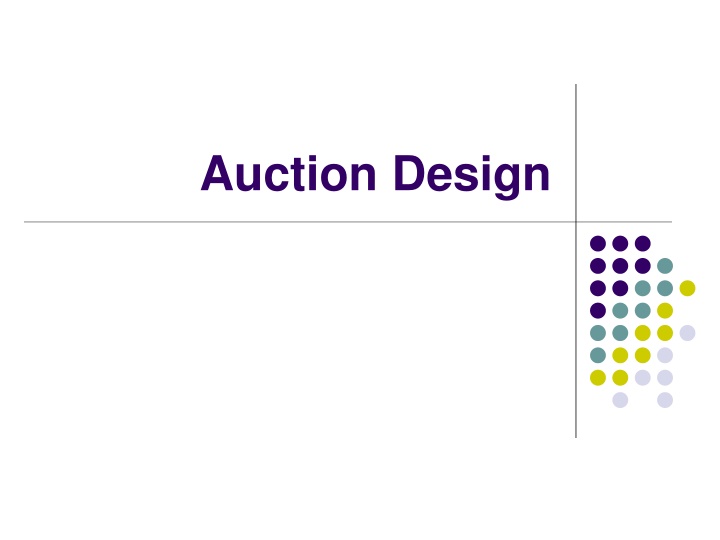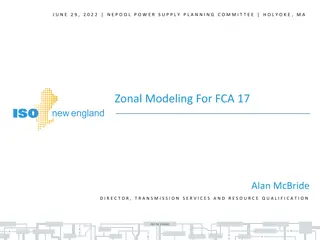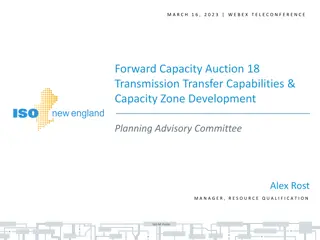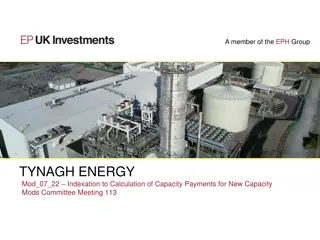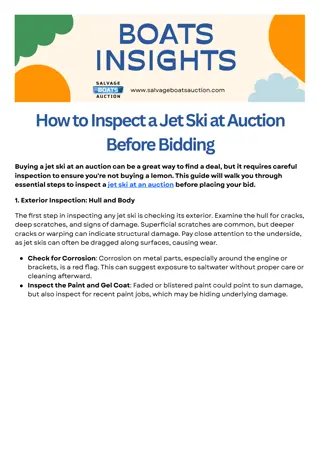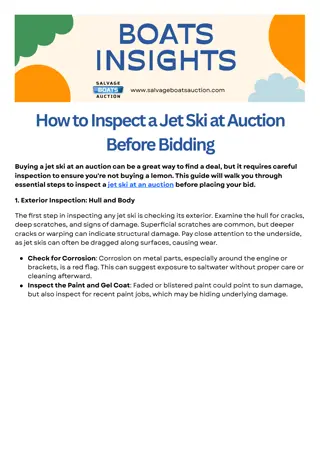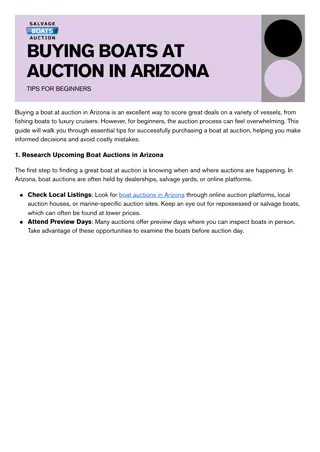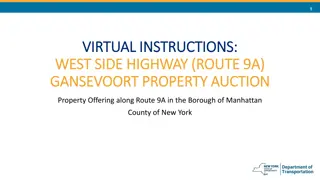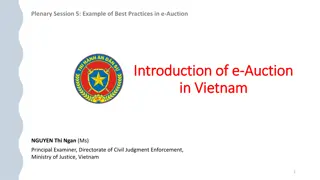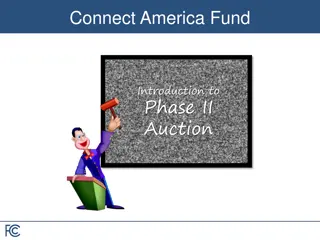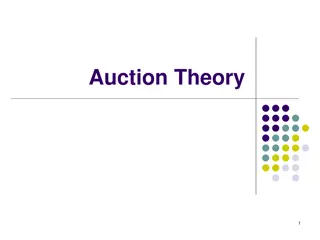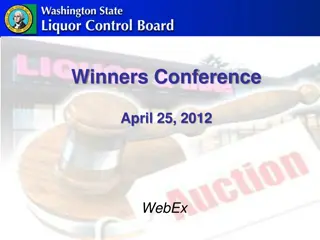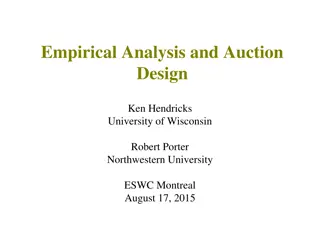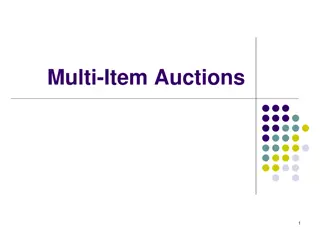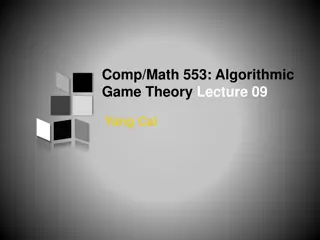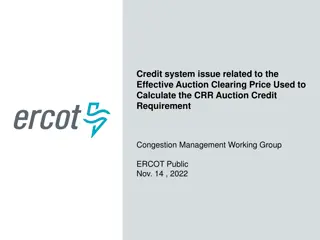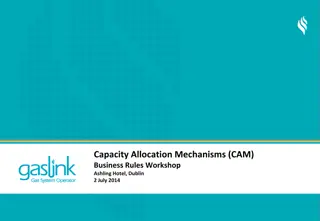Efficient Auction Design Strategies
auction design strategies such as reserve prices, bidder favoritism through subsidies, and considerations for entry and collusion. Delve into how setting reserve prices impacts revenue and learn about optimal reserve price calculations for different scenarios. Dive deeper into maximizing expected revenue and understanding the impact of competition.
Download Presentation

Please find below an Image/Link to download the presentation.
The content on the website is provided AS IS for your information and personal use only. It may not be sold, licensed, or shared on other websites without obtaining consent from the author.If you encounter any issues during the download, it is possible that the publisher has removed the file from their server.
You are allowed to download the files provided on this website for personal or commercial use, subject to the condition that they are used lawfully. All files are the property of their respective owners.
The content on the website is provided AS IS for your information and personal use only. It may not be sold, licensed, or shared on other websites without obtaining consent from the author.
E N D
Presentation Transcript
Background Last time: In a benchmark model with symmetric bidders we saw that if bidders play according to Nash equilibrium, then several common auction designs Result in an efficient allocation: high value bidder wins. Result in same expected revenue: equal to the expected second highest value. Today: think more about auction design Strategies to increase revenue: reserve prices Strategies to favor certain bidders: subsidies. Practical concerns: entry and collusion.
Reserve prices Two bidders, with values v1 and v2 Each vidrawn from uniform distribution on [0,100]. Last time we showed the expected revenue was 33. Can the seller benefit from setting a reserve price, i.e. a minimum price below which she won t sell?
Reserve prices, cont. Seller sets reserve price r Runs an ascending auction Clock starts from r and goes up, and bidders may choose not to be active at the beginning if they have low values. Three cases Both bidder values below r no sale. One value above r, one below r sale at r. Both values above r sale at lower value.
Revenue with reserve price Expected revenue (add up three cases & probabilities) Event Probability r r 2 r (1-r) (1-r) (1-r) Exp. Revenue v1, v2< r vi< r < vj v1, v2> r 0 r r + (1/3)(1-r) Expected revenue = 0 + 2r2(1-r) + (1-r)2[1/3 + (2/3)r] To maximize, set d(Exp Rev)/dr = 0 0= 4r - 6r2 - 2(1-r)(1/3+(2/3)r) + (2/3)(1-r)2 = 2r - 2r2
Optimal Reserve Price 1.2 50 Optimal reserve = 50 1 40 Probability of Sale Expected Revenue 0.8 30 0.6 20 0.4 10 0.2 0 0 0 10 20 30 40 Reserve Price 50 60 70 80 90 100 Probability of Sale Expected Revenue
Optimal Reserve with N=2,3 1.2 60 1 50 Probability of Sale Expected Revenue 0.8 40 0.6 30 0.4 20 0.2 10 0 0 0 10 20 30 40 50 60 70 80 90 100 Reserve Price Pr Sale (N=2) Pr Sale (N=3) Exp Rev (N=2) Exp Rev (N=3)
Reserve price & competition No Reserve (r=0) Optimal Reserve (r=0.5) N Pr(Sale) E[Rev] Pr(Sale) E[Rev] 1 1 0 0.50 25 2 1 33 0.75 42 3 1 50 0.88 53 4 1 60 0.95 61 5 1 67 0.97 67 Optimal reserve price is r=50 independent of number of bidders N (assuming all draw values from U[0,100]) - try it!
Evidence on reserve prices We ve seen how reserve prices work in theory but what about in practice. Does it help to set a higher reserve? Seems as if it might be hard to test At a used car auction, the bmws will have higher reserve prices than the chevys, but are also worth more. Best evidence would be experimental - sell multiple versions of the same thing with different reserve prices. Let s see if we can find some examples on eBay.
Effect of reserve on Pr(Sale) 100% Value $0-10 Value $10-30 80% Value $30-100 Value $100-1000 Probability of Sale 60% 40% 20% 0% Ratio of auction start price to reference value (s/v) From Einav, Kuchler, Levin, and Sundaresan (2012) Seller Experiments
Effect of reserve on price 1.40 Value $0-10 Value $10-30 Ratio of exp. sale price to reference value (p/v) Value $30-100 1.20 Value $100-1000 1.00 0.80 0.60 < 0.15 0.15-0.30 0.30-0.45 0.45-0.60 0.60-0.85 0.85-1.00 1.00-1.20 > 1.20 Ratio of auction start price to reference value (s/v)
Optimal reserve prices On eBay, the profit-maximizing reserve prices appear to be Very low reserve price: maximizes probability of sale and relies on competition to protect against low price outcome of auction. Or Very high reserve price: (close to item s posted price) low chance of sale, but seller is guaranteed a good price if auction succeeds. In practice, sellers mostly use very low ($0.99) reserve prices or high reserve prices that effectively work as posted prices.
Secret Reserve Prices? In many auctions, reserve prices are not announced in advance. Instead, the seller decides at the end if she wants to sell at the final auction price. Why might this be?
Used Car Auctions Live Car Auction From Larsen (2014) The Efficiency of Dynamic, Post-Auction Bargaining: Evidence from Wholesale Used-Auto Auctions
Used Car Auctions Larsen estimates that the secret reserve + negotiation mechanism is highly efficient!
Bidder Subsidies + Set-Asides In real-world auctions, it is common to see sellers choose to treat some bidders preferentially. Why? For distributional reasons: e.g. state and federal procurement explicitly favors domestic, small or minority- owned businesses by restricting entry or giving subsidies. For competition reasons: to level the playing field, or encourage entry and create competition as in the case of attracting a white knight to a takeover battle.
Raising Revenue at the FCC Ian Ayres and Peter Cramton have argued that the FCC s policy of subsidizing minority-owned firms raised revenue when the FCC started selling spectrum licenses in the 1990s. How? These firms pushed the large bidders to bid higher, raising the final auction prices.
FCC & Competition Policy Now, FCC is designing a new incentive auction to buy up the licenses of broadcast television companies, and create new licenses for wireless carriers to offer mobile broadband services. This is an attempt to address the so-called spectrum crunch facing mobile carriers.
FCC & Competition Policy Incentive auction objectives Get good prices for the wireless licenses in fact this is going to be necessary to pay the broadcasters! Ensure that there is a competitive telecom industry after the auction. Likely bidders include AT&T, Verizon, T-Mobile, Sprint, as well as smaller phone carriers. AT&T and Verizon are the big two . They own almost all of the best spectrum below 1000 MHz. This new auction will be some of the last spectrum of that type to be allocated.
FCC & Competition Policy Suppose the FCC plans to allocate 7 national licenses and bidders want to buy multiple licenses. How to ensure that there are more than two major players in the industry after the auction? Give smaller carriers an x% discount? Restrict each carrier to no more than x licenses? Restrict largest carriers to x licenses in total? Problem: how to choose x in each case! Set-asides provide more certainty about who wins, but might end up with lower revenue. A tricky problem
Optimal auction design We ve identified two ways to raise more revenue Reserve prices: withhold quantity to get a higher price. Subsidies: favor weak bidder to get more competition. General analysis of optimal or revenue-maximizing auctions (for which Myerson won 2007 Nobel Prize): Ascending auctions are efficient (high value bidder wins), but Sellers generally can benefit from distorting an auction away from efficiency in order to realize higher revenue (just like any monopolist!)
Optimal subsidies How Winner is Determined in Ascending Auctions with and without Subsidies 250 Ascending auction with a 6% small bidder subsidy Big bidder wins Big Bidder Value ($/mbf) 200 Revenue-maximizing auction favors small bidder and uses a reserve price 150 Regular ascending auction: high value bidder wins. 100 Big Bidder Reserve Small bidder wins 50 Small Bidder Reserve 0 0 50 Small Bidder Value ($/mbf) 100 150 200 250 From Athey, Coey, Levin (2013). Optimal auction estimated from US Forest Service timber auction data
Practical Issues Our analysis has assumed A fixed set of bidders willing to participate Bidders behave competitively, or non-cooperatively Practical auction design has to worry about Collusion - bidders may cooperate not compete Entry - can be hard to get bidders to participate
Collusion Collusion occurs if bidders agree in advance or during the auction to let prices settle at a low level. This is generally illegal, but it can and does happen. Concern is often biggest (and can be less obviously illegal) when there are multiple items for sale: e.g. you take these, I ll take these let s end the auction . With a single item collusion might rely on Side agreements: you win today, and share the profit with me. Intertemporal trades: you win today, I ll win tomorrow
Collusion: Example U.S. v. Pook (1988): Bidding ring that operated at antique auctions. When a dealer pool was in operation at a public auction of consigned antiques, those dealers who wished to participate in the pool would agree not to bid against the other members of the pool. If a pool member succeeded in purchasing an item at the public auction, pool members interested in that item could bid on it by secret ballot at a subsequent private auction ( knock out ) .... The pool member bidding the highest at the private auction claimed the item by paying each pool member bidding a share of the difference between the public auction price and the successful private bid. The amount paid to each pool member ( pool split ) was calculated according to the amount the pool member bid in the knock out. Court decision quoted in Kovacic, Marshall, Marx and Raiff (2005)
Collusion: Example The ring used an internal auction or knockout to coordinate bidding. Ring members would send a fax or supply a written bid to an agent (a New York taxi and limousine driver employed by the ring), indicating the lots in which they were interested, and what they were willing to bid for them in the knockout auction. The taxi driver would then collate all the bids, determine the winner of each lot, notify the ring as to the winners in the knockout and send the bids to another ring member who would coordinate the side payments after the target auction was concluded. Depending on who actually won the knockout, the taxi driver would, usually, either bid for the winner in the target auction, using the bid supplied in that auction as the upper limit, or organize for another auction agent to bid for the winner on the same basis. In the language of auction theory, the knockout was conducted using a sealed-bid format, with the winning bidder getting the right to own the lot should it be won by the ring in the target auction. The winning bid in the knockout set the stopping point for the ring s bidding in the target auction. Since bidding in the target auction was handled by the ring s agent, monitoring compliance with this policy was not a problem. Description of stamp bidding ring, from Asker (2010, AER)
The Stamp Ring Mechanism Bidders submit their offers to the ring auctioneer. High bidder, and high bidder only, enters main auction at his bid. If ring bidder wins, payments within the ring computed as follows First, subtract main auction payment from all ring bids. Throw away negative (net) bids that would have lost main auction. Bidders who made positive bids get to share in the ring gains. Look at increment from auction price up to first ring bid divide among all ring participants (could be equal, or 50% to winner and then equal). Then look at next increment and divide between all ring bidders who bid higher, and so forth. Winner makes side payments to losers so gains are split accordingly. Let s look at an example.
The Stamp Ring Mechanism Bidder Knockout Bid Bid net of Main Auction Price Private Side Payment 400 350 300 185 400 - 200 = 200 350 - 200 = 150 300 - 200 = 100 185 - 200 = -15 Pay 75 Get 50 Get 25 0 A B C D 200 Payment to Main Auction First increment of 100, split between A, B, C (1/2 to winner) Second increment of 50 split between A,B. Last increment of 50 goes to A.
Deterring Collusion What auction design works to deter collusion? Ascending: Suppose bidders A and B agree in advance that A should win at a low price. Although B can deviate from the agreement and keep bidding, A can just bid back - helps enforce the agreement. Sealed bidding If A and B agree that A should win at a low price, A must submit a low bid. But then B can send in a slightly higher bid and win the auction at a low price. Makes it harder to sustain collusion.
Entry A typical problem in organizing auction sales is to make sure that enough bidders will participate Auctions rely on having competition to set the price, and bidders may not want to participate unless they think they have a good chance. When might entry be a concern, and what can be done?
Entry example Two bidders, values drawn from U[0,100] and U[0,200]. Bidder expected profits from ascending auction Bidder 1 expects to win with probability 1/4. When he does win, he expects to have a value of 66 and to pay 33. So his overall expected profit if he participates is 8.3 Bidder 2 expects with probability to have a value above 100, and in this case make 150-50=100, or a value below 100, in which case he expects to make (1/2)*(66-33)=16.6. So his overall expected profit is 58.3 If the cost of entry is 10, Bidder 1 won t even bother. And Bidder 2 could end up winning at a price of zero!
Auction design to promote entry Subsidize weaker bidders Encourages their participation - can also restrict very strong bidders from entering (a set-aside policy) Subsidize entry costs directly E.g. in architectural competitions, architects partly reimbursed for building a model needed to submit a bid for the contract. Sealed bidding: (?) Prospect of very low prices in sealed bid auction encourages bidders to enter and try to steal the auction - whereas with open bidding, a strong bidder can respond.
Summary Auction design can involve multiple objectives Efficiency: making sure high value bidder wins Revenue: getting the best possible return on the sale Distributional: ensuring that certain bidders have a chance. There are often trade-offs between these objectives Reserve prices and subsidies can sometimes increase revenue even though they may distort the auction away from efficiency. Practical auction design also has to worry about basic economic issues such as collusion and entry.
Bid Subsidies Twobidders, values v1 and v2 Bidder 1 draws v1from uniform on [0,100]. Bidder 2 draws v2 from uniform on [0,200]. What will happen in an ascending auction? Both bidders will bid up to their values and the high value bidder will win - more likely to be Bidder 2 than Bidder 1.
Solving for the expected price There are two possible and equally likely cases Bidder 2 value is greater than 100. Then Bidder 2 wins for sure and pays Bidder 1 s value, which in expectation is 50. Bidder 2 s value is less than 100. Then Bidders 1 and 2 both have values U[0,100], so they are equally likely to win and the expected price is 33. So Bidder 2 wins with probability 3/4, Bidder 1 wins with probability 1/4, and the overall expected price is 41.6.
Bid Subsidies Suppose seller gives 50% discount to the weaker bidder: e.g. if weak bidder wins at a price of 50, only has to pay 25. What is the optimal weak bidder strategy? Bid up to 2v1 (at which point price is really v1) If watching the bidding, it will be as if both bidders have values drawn on [0,200], rather than [0,100] and [0,200].
Effect of the subsidy Bidders are equally likely to win. Expected clock price at end of auction is 66. Why? Expectation of lower of two draws from uniform [0,200]. Expected revenue is lower, however, equal to 50. Why? If bidder 1 wins, seller gets only half the price, so expected revenue is equal to *66 + *33 = 50.
Effect of subsidies With no subsidy Strong and weak bidder win with probability 3/4, 1/4. Seller gets expected revenue of 41.6. Auction is efficient: high value bidder wins. With subsidy for weak bidder Strong and weak bidder win with probability , . Seller gets expected revenue of 50. (Higher!) Auction is inefficient: weak bidder may win with lower value!
